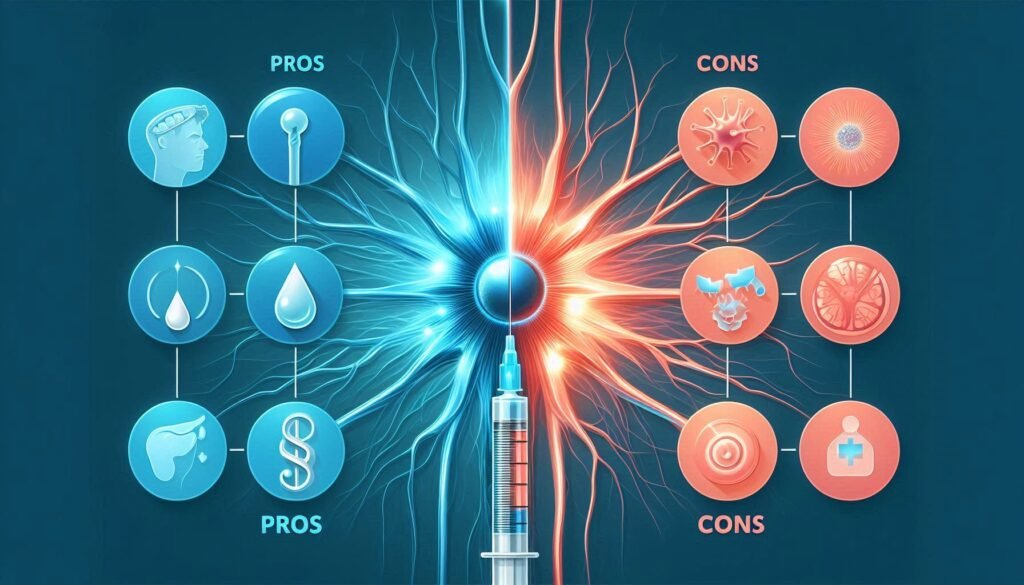Paresthesia can be a frustrating and debilitating condition. For those suffering from severe cases, the tingling, numbness, or burning sensations may disrupt daily life. While many individuals find relief through conservative treatments such as physical therapy or medication, some situations call for more drastic measures. Surgical interventions for severe cases of paresthesia offer hope to patients who have exhausted other options.
In this blog post, we will explore various surgical solutions available for managing paresthesia effectively. From addressing upper extremity issues like carpal tunnel syndrome to considering advanced techniques like deep brain stimulation, we’ll delve into each option’s benefits and considerations.
Understanding these surgical approaches can empower you with knowledge about what to expect if surgery becomes necessary in your journey toward relief from persistent nerve pain and discomfort. Join us as we navigate the complex landscape of surgical interventions designed specifically for those grappling with severe paresthesia symptoms.

Evaluating the Need for Surgical Treatment in Paresthesia Cases
Determining the need for surgical treatment in cases of paresthesia is a multi-faceted process. It begins with a thorough clinical evaluation, where healthcare providers assess the severity and duration of symptoms. Chronic or debilitating paresthesia that significantly impacts quality of life often warrants deeper investigation.
Diagnostic imaging techniques, such as MRI or ultrasound, can help identify underlying conditions causing nerve compression or damage. These assessments inform whether conservative treatments have been exhausted or if they are likely to provide adequate relief moving forward.
In some instances, additional tests like electromyography (EMG) may be performed to gauge nerve function and pinpoint specific issues. The results from these evaluations guide physicians in recommending appropriate interventions.
Patient history plays a crucial role in decision-making. Factors such as age, overall health status, and personal preferences must be considered when weighing surgical options against potential risks and benefits.
Carpal Tunnel Release: Addressing Upper Extremity Paresthesia
Carpal tunnel syndrome is a common cause of upper extremity paresthesia. It occurs when the median nerve, which runs through the wrist, becomes compressed. This condition often leads to symptoms like numbness, tingling, and weakness in the hand and fingers.
When conservative treatments fail to provide relief, surgical intervention may be necessary. Carpal tunnel release surgery aims to alleviate pressure on the median nerve by cutting the transverse carpal ligament. By creating more space within the carpal tunnel, this procedure can significantly reduce pain and restore function.
Patients typically experience quick improvements after surgery. Many report reduced discomfort almost immediately following the procedure. Recovery usually involves several weeks of rehabilitation focused on strengthening and regaining full motion.
The success rate for carpal tunnel release is high, with many patients resuming normal activities shortly after recovery. Understanding this option empowers those suffering from severe paresthesia to explore all avenues toward effective treatment.
Ulnar Nerve Decompression: Surgical Options for Cubital Tunnel Syndrome
Ulnar nerve decompression is a key surgical intervention for cubital tunnel syndrome, a condition marked by increased pressure on the ulnar nerve at the elbow. This compression can lead to symptoms like tingling, numbness, or weakness in the hand and fingers. Identifying this condition early is crucial for successful treatment.
During the surgery, surgeons may perform various techniques to relieve pressure on the nerve. One common approach involves simply releasing soft tissue around the ulnar nerve. In more severe cases, surgeons might reposition or transpose the nerve to prevent future compression.
Patients can expect reduced symptoms post-surgery; however, recovery varies depending on individual health factors and severity of pre-existing conditions. Physical therapy is often recommended after surgery to enhance mobility and strength.
Like all surgeries, ulnar nerve decompression carries risks such as infection or persistent discomfort. Understanding these possibilities helps patients make informed decisions about their treatment options for better long-term outcomes.
Spinal Decompression Surgery: Relieving Nerve Root Pressure
Spinal decompression surgery is a procedure aimed at relieving pressure on the spinal nerves. This condition often arises from herniated discs, bone spurs, or other spinal abnormalities that can compress nerve roots. Patients experiencing severe paresthesia due to these issues may find this surgical option beneficial.
During the procedure, surgeons remove portions of bone or disc material that are causing nerve compression. This creates more space for the affected nerves and helps alleviate symptoms such as tingling, numbness, and pain in various body regions. The surgery can be performed through traditional open techniques or minimally invasive methods.
Recovery times vary depending on individual health factors and the extent of the surgery. Most patients experience significant improvement in their symptoms post-surgery, with many returning to normal activities within weeks.
It’s essential for patients to discuss all options with their healthcare provider before deciding on surgery. Understanding potential outcomes and associated risks will help set realistic expectations during recovery.
Peripheral Nerve Decompression: Targeting Specific Problem Areas
Peripheral nerve decompression focuses on relieving pressure from specific nerves that can cause debilitating paresthesia. This surgical intervention is often recommended when conservative treatments, such as physical therapy and medication, fail to provide relief. By targeting the affected area directly, surgeons aim to restore normal function.
Common conditions warranting peripheral nerve decompression include carpal tunnel syndrome and ulnar nerve entrapment. During these procedures, the surgeon carefully identifies and removes any structures compressing the nerve—such as ligaments or bony growths—to alleviate symptoms effectively.
The benefits of this targeted approach are significant. Patients often report immediate relief from tingling sensations, numbness, and pain post-surgery. Furthermore, timely intervention can prevent permanent nerve damage.
Recovery time varies depending on the extent of surgery but generally allows patients to return to daily activities quicker than more invasive options might permit. Close follow-up care ensures optimal healing while monitoring for any potential complications.
Minimally Invasive Techniques: Reducing Recovery Time and Complications
Minimally invasive techniques have revolutionized the surgical landscape for treating severe cases of paresthesia. These approaches typically involve smaller incisions, which significantly reduce tissue damage compared to traditional surgery. As a result, patients often experience less postoperative pain and discomfort.
One of the key advantages is the shortened recovery time. Many individuals can return to their daily activities much sooner than with conventional methods. This means less time off work and a quicker overall transition back to normal life.
Moreover, minimally invasive procedures tend to lead to fewer complications, such as infections or excessive bleeding. Surgeons use advanced imaging technologies that enhance precision during operations, minimizing risks associated with nerve damage.
Patients also report better aesthetic outcomes due to reduced scarring from smaller incisions. With these benefits in mind, it’s clear why many are choosing minimally invasive options when considering surgical interventions for severe cases of paresthesia.
Deep Brain Stimulation: A Frontier in Paresthesia Treatment
Deep Brain Stimulation (DBS) is emerging as a promising option for managing severe cases of paresthesia. This innovative procedure involves implanting electrodes in specific brain regions known to regulate sensory pathways. By delivering targeted electrical impulses, DBS can significantly alter the way the brain processes sensations.
One of the significant advantages of DBS is its ability to provide relief without damaging surrounding tissues. Unlike traditional surgery that might sever or remove nerve fibers, this technique modulates neural activity while preserving function. Patients often report improvements in their symptoms following stimulation adjustments tailored to their needs.
Research indicates that patients with chronic pain and related paresthesia conditions may benefit greatly from this intervention. However, it’s essential for candidates to undergo comprehensive evaluations before proceeding with DBS, ensuring they are suitable for this advanced treatment.
As technology progresses and our understanding deepens, deep brain stimulation could redefine how we approach complex neuropathic disorders like paresthesia. The potential impact on quality of life remains an exciting prospect for both patients and healthcare providers alike.
Post-Surgical Rehabilitation: Ensuring Optimal Outcomes
Post-surgical rehabilitation plays a crucial role in achieving the best outcomes after surgical interventions for severe cases of paresthesia. Tailored physical therapy programs are designed to restore strength, flexibility, and function to the affected areas. These personalized plans often begin soon after surgery to promote healing and prevent stiffness.
Patients may engage in gentle exercises that gradually increase in intensity as they progress. This helps rebuild muscle strength while minimizing discomfort. A qualified therapist will monitor each patient’s recovery closely, making adjustments as needed based on their individual responses.
Education is also vital during this phase. Patients learn about proper body mechanics and activity modifications to protect the surgical site and avoid complications. Understanding post-operative care significantly aids recovery.
Additionally, emotional support can enhance rehabilitation success. Many patients face anxiety or frustration during recovery; addressing these feelings through counseling or support groups can improve adherence to rehabilitation plans, ultimately leading to better results.
Potential Risks and Complications of Paresthesia Surgery
Surgical interventions for severe cases of paresthesia can offer significant relief, but they also come with potential risks and complications. One common concern is infection at the surgical site. Despite strict sterile techniques, post-operative infections can occur, leading to further complications that may require additional treatment.
Nerve damage represents another risk associated with these surgeries. While surgeons strive to avoid harming surrounding nerves, inadvertent injury can happen during procedures. This could result in new or worsening symptoms following surgery.
There’s also a possibility of incomplete symptom resolution. Some patients may not experience the full relief they had hoped for after surgery. In some cases, residual paresthesia might continue even after the targeted nerve has been decompressed.
Scarring and adhesions are potential long-term issues from surgical intervention. Scar tissue formation around nerves can lead to persistent discomfort or even recurrence of symptoms over time.
Long-Term Prognosis: What to Expect After Surgical Intervention
After undergoing surgical interventions for severe cases of paresthesia, patients often wonder about their long-term prognosis. Many factors influence recovery outcomes, including the specific type of surgery performed and the underlying cause of the paresthesia.
Generally, most patients experience significant relief from symptoms post-surgery. Those treated for conditions like carpal tunnel syndrome or ulnar nerve compression typically report improved sensation and reduced discomfort within weeks to months after their procedures. However, full recovery may take longer depending on individual healing processes.
It’s essential to adhere to rehabilitation protocols recommended by healthcare providers. Effective physical therapy can enhance strength and mobility in affected areas while helping prevent future complications. Some individuals may notice a gradual decrease in symptoms over time as nerves heal and regain function.
Regular follow-ups with your medical team are crucial for monitoring progress. While many people achieve favorable outcomes after surgery, it’s important to remain mindful that some might continue to experience mild residual symptoms or require additional treatment options down the line.
Maintaining open communication with your healthcare provider will support an informed journey toward optimal health following surgical intervention for paresthesia.


